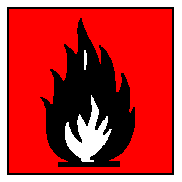International Chemical Safety Cards
| ZINC PHOSPHIDE | ICSC: 0602 |
| ZINC PHOSPHIDE Trizinc diphosphide Zn3P2 Molecular mass: 258.1 CAS # 1314-84-7 RTECS # ZH4900000 ICSC # 0602 UN # 1714 EC # 015-006-00-9 |
 |
 |
| TYPES OF HAZARD/ EXPOSURE |
ACUTE HAZARDS/ SYMPTOMS |
PREVENTION | FIRST AID/ FIRE FIGHTING |
| FIRE | Not combustible but forms
flammable gas on contact with water or damp air. |
NO contact with acid(s),
water or oxidants. |
Powder. Dry sand. NO water.
NO carbon dioxide or halons. |
| EXPLOSION | |
|
In case of fire: keep
drums, etc., cool by spraying with water but NO direct contact with water. |
| EXPOSURE | |
PREVENT DISPERSION OF DUST!
STRICT HYGIENE! |
|
| INHALATION | Cough. Diarrhoea.
Headache. Fatigue. Nausea. Vomiting. |
Local exhaust or breathing
protection. |
Fresh air, rest.
Half-upright position. Refer for medical attention. |
| SKIN | |
Protective gloves. |
Remove contaminated
clothes. Rinse and then wash skin with water and soap. |
| EYES | |
Safety goggles. |
First rinse with plenty of
water for several minutes (remove contact lenses if easily possible), then take to a
doctor. |
| INGESTION | Abdominal pain. Cough.
Diarrhoea. Dizziness. Headache. Laboured breathing. Nausea. Unconsciousness.
Vomiting. Ataxia. Fatigue. |
Do not eat, drink, or smoke
during work. |
Give a slurry of activated
charcoal in water to drink. Induce vomiting (ONLY IN CONSCIOUS PERSONS!). Refer for
medical attention. |
| SPILLAGE DISPOSAL | STORAGE | PACKAGING & LABELLING | ||
| Evacuate danger area!
Consult an expert! Sweep spilled substance into containers. Carefully collect remainder,
then remove to safe place. Do NOT let this chemical enter the environment (extra personal
protection: complete protective clothing including self-contained breathing apparatus). |
Separated from strong
oxidants, acids, water. Cool. Dry. Keep in a well-ventilated room. |
F symbol T+ symbol R: 15/29-28-32 S: 3/9/14-30-36/37-45 UN Haz Class: 4.3 UN Subsidiary Risks: 6.1 UN Pack Group: I Marine pollutant. |
||
| SEE IMPORTANT INFORMATION ON BACK | ||||
|
||||